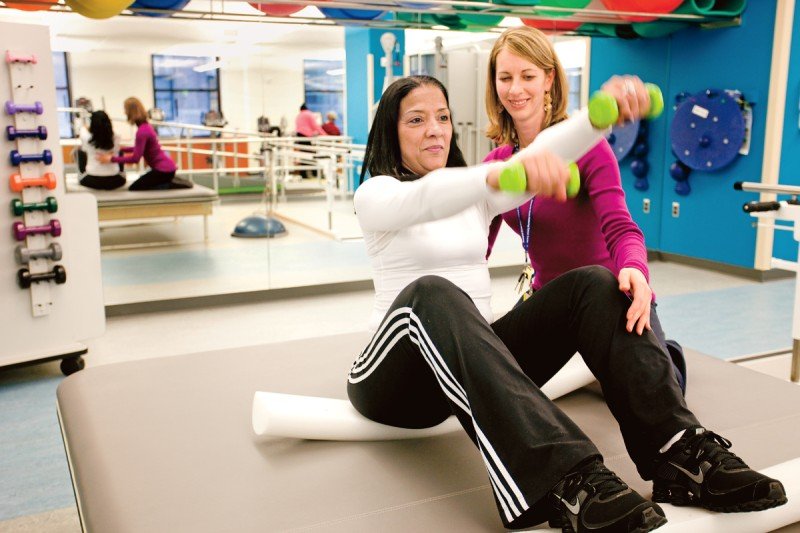
Physical therapist Sharlynn Tuohy works with a patient to rebuild muscle strength.
After undergoing breast cancer surgery, many women experience lasting pain or discomfort in the breast or chest area. Called postmastectomy reconstruction syndrome (PMRS), this condition is a reality for up to half of women who have breast cancer surgery.
“We use the term postmastectomy reconstruction syndrome to describe specific symptoms that some women may experience after treatment for breast cancer,” explains Memorial Sloan Kettering physiatrist Katarzyna Ibanez.
Although the name implies that only women who have undergone mastectomy (surgical removal of the breast and underlying tissue) experience PMRS, the symptoms may be caused by a number of treatments for breast cancer: surgery, lymph node biopsy, reconstruction, chemotherapy, or radiation.
“Whatever the cause, treatment and management are essential so women can get back to their lives in the most comfortable way possible,” Dr. Ibanez says.
A Range of Symptoms
Women with PMRS may experience weakness, tightness, or pain in the shoulder; muscle loss in the chest wall; or muscle spasms and pain. Some women say they have trouble taking a deep breath, comparing the sensation to wearing an “iron bra,” Dr. Ibanez explains.
Other signs include:
- swelling of the chest wall
- sensitivity to touch on the chest wall or armpit
- restricted range of motion
- axillary web syndrome (also called cording, in which ropelike tissue structures form under the skin of the arms)
- breast tightness
These symptoms, which can range from mildly annoying to severely restricting, might not be present right after surgery but can pop up years later.
Seeking the Right Diagnosis
If you have complaints of pain or discomfort after breast cancer surgery, you may find that it can be hard to get a diagnosis. The surgeon has removed the cancer and the oncologist has done his or her job, but how does the leftover pain get diagnosed and treated?
If you think you may have PMRS, make an appointment with a physiatrist in your area, Dr. Ibanez advises. He or she will need to take a detailed medical and functional history. A comprehensive physical exam, which includes seeing how well you can move, may help your doctor determine if there are underlying problems with your nerves, muscles, or other tissues.
Sometimes, blood tests or an imaging test such as an MRI may be needed. A test called an electromyography can help to see if there is abnormal muscle or nerve function in the area.
Finding the Solution
Treatment for PMRS is as varied as its symptoms are, which means there is no specific intervention that will work for all women.
Rehabilitative treatments may include medication, occupational and physical therapy, and lymphedema therapy.
The mainstay of treatment is a highly specialized physical therapy that reeducates the affected muscles and nerves, improves posture and body awareness, stretches the chest wall muscles, strengthens other muscles, and restores joint and soft tissue mobility.
Pain medications may be effective for some women. Others find relief from botulinum toxin (Botox®) or other injections that may reduce or eliminate painful spasms.
In determining a treatment plan for her patients, Dr. Ibanez says, it’s important for her to know more about their lives. Your doctor should be asking questions like:
- What kind of activities, hobbies, and sports do you participate in?
- What type of job do you do?
- What have you found the most disabling?
- What activities do you most want to return to, and is there a timeframe or any other factors to keep in mind?
Other factors to take into account are how long the symptoms have been present and what treatments, if any, have already been tried.
Getting Back to Normal
Many women come to her office seeking help, Dr. Ibanez says, and are relieved to hear that they aren’t alone — and that there is treatment. “It’s important that women with PMRS understand that this is a real syndrome,” she stresses. “There is a physiology to it. There is nerve and muscle damage, atrophy, and a change in biomechanics.”

With a comprehensive program that can last six, eight, or 12 weeks, followed by a lifelong exercise program to maintain the gains, most women will feel much better. “We can never say 100 percent, but I would say 80 to 90 percent of women see great improvements,” says Dr. Ibanez. She adds that it’s important to continue the exercises after the completion of therapy, because symptoms may return or worsen.
“My patients say that life isn’t the same as before cancer treatment, but it’s better than when they first came to see me,” she notes. “They can participate in activities like yoga and swimming, and they can lift their child or grandchild.”


